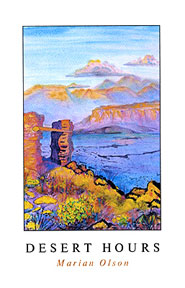Marian Olson’s Desert Hours
 Review of Marian Olson’s Desert Hours. Northfield, Massachusetts: Lily Pool Press, 2007. Art by Karen Fitzsimmons. Letterpress, sewn binding, 109 pages, ISBN 978-0-934714-35-8.
Review of Marian Olson’s Desert Hours. Northfield, Massachusetts: Lily Pool Press, 2007. Art by Karen Fitzsimmons. Letterpress, sewn binding, 109 pages, ISBN 978-0-934714-35-8.
Poetry, with a life of its own, may sometimes be attracted to words, but can never be captured by them. The poet wishes to participate in creation, in how the world is shaped, and in how she herself is shaped by the world. She knows that words are real and palpable, a means of making contact, without which the world is incomplete. By this love Marian Olson has allowed herself and her poems to be shaped by the high desert of the Sangre de Cristo mountains in New Mexico, by the impossible blooming of all that lives there, and by the mineral realities of death. They are not divided:
potter’s wheel
inside and out the shape
of her clay
Through intimacy with the contours of the land she inhabits, its moods, creatures, and fellow inhabitants present and past, and through a felt sense of the interrelatedness of these elements, Olson’s haiku both reveal and transcend the moment; they have a richness and depth, apparent in individual poems, but increasingly and variously revealed in relation to each other, in correspondences and subtle linkage. Often in Desert Hours, one poem, having left its impression, will ripple and re-emerge in another, and find new or different life there:
river’s song
a wounded turtle
slips into it
whole as the snakeskin surrender
What I wish to emphasize is the trust one can place in these discoveries: the connections are not random. Just as the high desert (and all of nature) reveals itself to the one who is willing to listen, a good book will teach us how to read.
Olson’s poems never feel forced; there is no need to search for underlying meaning—it simply is, unfolding with the inevitability of sunrise, and the shaping of a hawk’s wings. And so, whether or not she intended it, I feel not only the
potter’s wheel but some kind of mythic sun in this haiku and elsewhere:
summer thermal
a wheel of ravens
spins out of sight
Other readers, of course, will find other correspondences, but it will not be because the poems are so vague as to be about whatever the reader wishes, but that they are real enough to withstand multiple use.
Themes emerge like springs, and go back underground, to reemerge elsewhere. Emergence itself—awakening—is an important theme in this book, explored at times explicitly:
deep in barn shadows
the owl’s white face
out of nowhere
the sweetness of a rose
country graveyard
and at times implied:
dark is dark
a twig snaps
in the arroyo
If Olson were a less mature, less assured writer, she likely would have settled on a first line more like: the dark, and written a good enough haiku, evocative of mystery. But to my imagination she has gone further, and the haiku, not losing any sense of mystery or drama, encompasses more than that, an acceptance of reality as it is, both sensible and unknowable.
Emergence and disappearance, like so many seeming opposites in these poems, play out together, as linked as the inside and outside of the potter’s clay:
winter sun
you choose to die
with a shrug
twilight sun
slips into another
dark world
These then, are poems of great sensuality and spirituality. Inseparable.
if you love me
come inside
morning glory
This may be seen as sexually explicit, and it is, but the spiritual longing is equally evident. As with “dark is dark,” it presents a fact, a realization: the beloved has a beautiful form, and dwells within. For me, this is one of several key poems in which Olson’s themes ring clearly and can be heard again and again in other poems, amplified, altered, surprising.
Here is another key poem:
the world having become
what it is
I plant a few bulbs
in which objectivity and subjectivity rest beautifully in one another’s arms, mutually shaping, mutually falling away. Marian Olson loves the sun-struck, moon-cooled world she inhabits, endlessly revealing itself, endlessly concealed. And when love is mature in its acceptance of reality, of the beloved, expression follows, words take shape, and poetry is helpless to resist.
![]()
